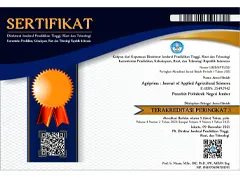Efikasi Asap Cair Hasil Pirolisis Pelepah Sawit untuk Pengendalian Kutu Kebul dan Pengaruhnya Terhadap Tanaman Cabai Merah
DOI:
10.25047/agriprima.v7i2.517Downloads
Abstract
Bemisia tabaci Genn merupakan vektor hama begomovirus CMV, TMV, ChiVMV, PepYLCV pada tanaman cabai. Berbagai penelitian telah memastikan efektivitas asap cair menurunkan jumlah serangga dan mampu mengendalikan kerusakan yang diakibatkannya. Pelepah kelapa sawit merupakan bahan baku lokal yang melimpah yang dapat dipirolisis menjadi asap cair dan diduga dapat mengendalikan intensitas serangan serangga pada tanaman cabai. Tujuan penelitian ini adalah menganalisis pengaruh asap cair pelepah kelapa sawit terhadap jumlah nimfa kutu kebul, intensitas serangannya terhadap tanaman, mengetahui pengaruhnya terhadap pertumbuhan tanaman, dan mengetahui hubungan dosis pemberian asap cair terhadap ketahanan tanaman. Penelitian ini dilakukan dalam rancangan acak lengkap dengan 32 percobaan ulangan di dalam screen UV Politeknik Hasnur dari Desember 2021 hingga Mei 2022. Analisis data menggunakan model uji Tukey's HSD dengan 5% α. Hasil penelitian menunjukkan bahwa 15 mL per 1000 mL asap cair yang terbuat dari pelepah sawit mengurangi jumlah nimfa dan intensitas serangan, tetapi pertumbuhan tanaman menjadi tercekam dengan korelasi negatif (R2 = 35%) terhadap ketahanan tanaman pada setiap peningkatan dosis. Hasil ini menunjukkan bahwa penerapan asap cair harus bersentuhan langsung dengan organisme pengganggu tumbuhan.
Keywords:
Cabai merah Efikasi Kutu Kebul Pelepah sawitReferences
Abdillah, M. H. (2021). Improvement Nutrient Uptake with Application of Organic Matter to Increase Resistance of Cayenne Pepper to Whitefly Virulence. Jurnal Agronomi Indonesia, 49(3), 280–287.
Abdillah, M. H., Lukmana, M., Indriani, I., & Nur, R. (2023). Iptek bagi Masyarakat dalam Mengolah Biomassa menjadi Biochar dan Asap Cair Menggunakan Pirolisator Portabel. Sasambo: Jurnal Abdimas (Journal of Community Service), 5(1), 31–40.
Abubakar, M., Koul, B., Chandrashekar, K., & Raut, A. (2022). Whitefly (Bemisia tabaci) Management (WFM) Strategies for Sustainable Agriculture : A Review. Agriculture (Switzerland), 12(7), 1317–1343.
Amri, K., Dalimunthe, B. A., Sepriani, Y., & Harahap, F. S. (2022). Efektivitas asap cair terhadap mortalitas Kutu Putih (Bemasia tabaci Cream) pada tanaman Mentimun. Jurnal Pertanian Agros, 24(1), 444–451.
Andersen, E. J., Ali, S., Byamukama, E., Yen, Y., & Nepal, M. P. (2018). Disease Resistance Mechanisms in Plants. Genes, 9(7), 70339–70368.
Asikin, S., & Abdillah, M. H. (2022). Efektivitas ekstrak tanaman hutan rawa sebagai bioinsektisida dalam mengendalikan Spodoptera litura F. pada skala laboratorium. EnviroScienteae, 18(3), 39–46.
Bonanomi, G., Jesu, G., Zotti, M., Idbella, M., D’Errico, G., Laudonia, S., Vinale, F., & Abd-ElGawad, A. (2021). Biochar-derived smoke-water exerts biological effects on nematodes, insects, and higher plants but not fungi. Science of the Total Environment, 750(9), 142307.
Christina, R., & Marsuni, Y. (2020). Teknologi pengendalian hama serangga cabai rawit (Capsicum
frutencens L.) kombinasi dengan ekstrak mahkota dewa (Phaleria macrocarpa) dan jarak tanam. Prosiding Seminar Nasional Lingkungan Lahan Basah, 5(4), 158–167.
Diptaningsari, D., Meithasari, D., Karyati, H., & Wardani, N. (2022). Potential Use of Coconut Shell Liquid Smoke as an Insecticide on Soybean and the Impact on Agronomic Performance. IOP Conference Series: Earth and Environmental Science, 985(1), 2058–2065.
Divekar, P. A., Narayana, S., Divekar, B. A., Kumar, R., Gadratagi, B. G., Ray, A., Singh, A. K., Rani, V., Singh, V., Singh, A. K., Kumar, A., Singh, R. P., Meena, R. S., & Behera, T. K. (2022). Plant Secondary Metabolites as Defense Tools against Herbivores for Sustainable Crop Protection. International Journal of Molecular Sciences, 23(5), 2690–2714.
Eigenbrode, S. D., Ding, H., Shiel, P., & Berger, P. H. (2002). Volatiles from potato plants infected with potato leafroll virus attract and arrest the virus vector, Myzus persicae (Homoptera: Aphididae). Proceedings of the Royal Society: Biological Sciences, 269(7), 455–460.
Farida, L., & Ratnasari, E. (2019). Pengaruh Asap Cair Serbuk Gergaji Kayu Jati (Tectona grandis) terhadap Mortalitas Kutu Daun (Aphis gossypii). Lentera Bio, 8(1), 44–49.
Fereres, A., Peñaflor, M. F. G. V., Favaro, C. F., Azevedo, K. E. X., Landi, C. H., Maluta, N. K. P., Bento, J. M. S., & Lopes, J. R. S. (2016). Tomato infection by whitefly-transmitted circulative and non-circulative viruses induce contrasting changes in plant volatiles and vector behaviour. Viruses, 8(8), 225–244.
Gama, Z. P., Purnama, R. M. A., & Melani, D. (2021). High potential of liquid smoke from coconut shell (Cocos nucifera) for biological control of rice bug (Leptocorisa oratorius Fabricius). Journal of Tropical Life Science, 11(1), 85–91.
Guerriero, G., Hausman, J. F., & Cai, G. (2014). No stress! relax! mechanisms governing growth and shape in plant cells. International Journal of Molecular Sciences, 15(3), 5094–5114.
Hammerbacher, A., Coutinho, T. A., & Gershenzon, J. (2019). Roles of plant volatiles in defence against microbial pathogens and microbial exploitation of volatiles. Plant Cell and Environment, 42(10), 2827–2843.
Haryadi, N. T., Muhlison, W., & Al-Ashar, M. B. D. (2022). Efektifitas penanaman refugia terhadap populasi dan intensitas serangan hama kutu kebul (Bemisia tabaci) pada pertanaman cabai merah besar (Capsicum annum L.). Jurnal Bioindustri, 4(2), 135–148.
Hasterok, R., & Betekhtin, A. (2020). Plant cell and organism development. International Journal of Molecular Sciences, 21(16), 1–10.
Hernani, Yuliani, S., & Rahmini. (2021). Natural biopesticide from liquid rice hull smoke to control brown planthopper. IOP Conference Series: Earth and Environmental Science, 733(1).
Hertianti, E., Suwinarti, W., Supraptono, B., Aryani, F., & Kusuma, I. W. (2022). Phytochemicals, antioxidants activity, total phenolic and total flavonoid content of liquid smoke from tropical plants. International Journal of Biosciences, 21(6), 316–321.
Hülskamp, M. (2004). Plant trichomes : A model for cell differentiation. Nature Reviews Molecular Cell Biology, 5(6), 471–480.
Lukmana, M., Karunia, D., & Majid, Z. A. N. M. (2022). Pertumbuhan bibit kelapa sawit dengan aplikasi asap cair limbah pelepah kelapa sawit. Ziraa’ah, 47(1), 129–136.
Marianah, L. (2020). Serangga Vektor dan Intensitas Penyakit Virus pada Tanaman Cabai Merah. AgriHumanis: Journal of Agriculture and Human Resource Development Studies, 1(2), 127–134.
Mauck, K., Bosque-Pérez, N. A., Eigenbrode, S. D., De Moraes, C. M., & Mescher, M. C. (2012). Transmission mechanisms shape pathogen effects on host-vector interactions: Evidence from plant viruses. Functional Ecology, 26(5), 1162–1175.
Maulina, S., & Mentari, V. A. (2019). Comparison of Functional Group and Morphological Surface of Activated Carbon from Oil Palm Fronds Using Phosphoric Acid (H3PO4) and Nitric Acid (HNO3) as an Activator. IOP Conference Series: Materials Science and Engineering, 505(1), 2023–2028.
Maulina, S., & Silia, F. (2018). Liquid smoke characteristics from the pyrolysis of oil palm fronds. IOP Conference Series: Materials Science and Engineering PAPER, 2073–2078.
Murgianto, F., Hidayat, P., & Triwidodo, H. (2023). Bemisia tabaci (Hemiptera: Aleyrodidae): evaluation of leaf trichome density based resistance on several soybean varieties. Jurnal Hama Dan Penyakit Tumbuhan Tropika : Journal of Tropical Plant Pests and Diseases, 23(1), 9–14.
Nault, B. A., & Huseth, A. S. (2016). Evaluating an Action Threshold-Based Insecticide Program on Onion Cultivars Varying in Resistance to Onion Thrips (Thysanoptera : Thripidae). Journal of Economic Entomology Advance, 109(4), 1–7.
Ngou, B. P. M., Ahn, H. K., Ding, P., & Jones, J. D. G. (2021). Mutual potentiation of plant immunity by cell-surface and intracellular receptors. Nature, 592(3), 110–115.
Paiman. (2019). Teknik Analisis Korelasi dan Regresi Ilmu-Ilmu Pertanian (N. N. S. Dwipa (ed.); 1st ed.). Universitas Pendidikan Yogyakarta Press.
Paramita, K., & Suharsono, S. (2018). Efikasi Insektisida Nabati dalam Mengendalikan Kutu Kebul Bemisia tabaci Genn. (Homoptera : Aleyrodidae). Widyariset, 17(2), 219–226.
Pares, R. D. (1992). Fundamentals of Plant Virology. In Australasian Plant Pathology (Vol. 21, Issue 4). Springer Nature.
Parisi, M., Alioto, D., & Tripodi, P. (2020). Overview of Biotic Stresses in Pepper (Capsicum spp.): Sources of Genetic Resistance, Molecular Breeding and Genomics. International Journal of Molecular Sciences, 21(7), 2587–2626.
Praditya, N. Y., & Syafrial, S. (2017). Analisis faktor-faktor keputusan pembelian petani padi terhadap produk pestisida nabati. Jurnal Ekonomi Pertanian Dan Agribisnis (JEPA), I(2), 1–7.
Rahmawati, L. (2020). Analisa komparatif usaha tani padi yang menggunakan pestisida nabati dan pestisida kimia (studi kasus di kelompok tani Tirtodimulyo Tiga Desa Klampokan Kecamatan Panji Kabupaten Situbondo). Agribios, 18(2), 94–104.
Ratna, Y., Trisyono, Y. A., Untung, K., & Indradewa, D. (2009). Resurjensi serangga hama karena perubahan fisiologi tanaman dan serangga sasaran setelah aplikasi insektisida. Jurnal Perlindungan Tanaman Indonesia, 15(2), 55–64.
Rizal, W. A., Nisa, K., Maryana, R., Prasetyo, D. J., Pratiwi, D., Jatmiko, T. H., Ariani, D., & Suwanto, A. (2020). Chemical composition of liquid smoke from coconut shell waste produced by SME in Rongkop Gunungkidul. IOP Conference Series: Earth and Environmental Science, 462(1), 2057–2064.
Saputra, R. Y., Naswir, M., & Suryadri, H. (2020). Perbandingan Karakteristik Asap Cair pada Berbagai Grade dari Pirolisis Batubara. Jurnal Engineering, 2(2), 96–108.
Selvakumar, R., Singh, D. C. M., & Singh, P. K. (2016). Capsicum: Breeding prospects and perspectives for higher productivity. In New Perspectives (pp. 31–45).
Siddik, P., Dalimunthe, B. A., Sepriani, Y., & Rizal, K. (2022). Analisis kandungan asap cair dari pelepah kelapa sawit dan batok kelapa serta perbandingan pH pelepah kelapa sawit dan batok kelapa. Jurnal Pertanian Agros, 24(2), 607–611.
Sudiono, S., & Purnomo, P. (2009). Hubungan antara populasi kutu kebul (Bemisia tabaci Genn.) dan penyakit kuning pada cabai di Lampung Barat. Jurnal Hama Dan Penyakit Tumbuhan Tropika, 9(2), 115–120.
Sudo, M., Takahashi, D., Andow, D. A., Suzuki, Y., & Yamanaka, T. (2018). Optimal management strategy of insecticide resistance under various insect life histories: Heterogeneous timing of selection and interpatch dispersal. Evolutionary Applications, 11(2), 271–283.
Tafsin, M., Hanafi, N. D., Yunilas, & Mulianda, R. (2019). Nutrient quality of oil palm frond fermented by local microorganism (MOL) with different dosage and incubation time. IOP Conference Series: Earth and Environmental Science, 260(1), 2050–2057.
Tian, H., Wu, Z., Chen, S., Ao, K., Huang, W., Yaghmaiean, H., Sun, T., Xu, F., Zhang, Y., Wang, S., Li, X., & Zhang, Y. (2021). Activation of TIR signalling boosts pattern-triggered immunity. Nature, 598(9), 500–503.
Urrutia, R. I., Gutierrez, V. S., Stefanazzi, N., Volpe, M. A., & Werdin González, J. O. (2022). Pyrolysis liquids from lignocellulosic biomass as a potential tool for insect pest management: A comprehensive review. Industrial Crops and Products, 177, 114533.
Utami, K. A. S., & Damanhuri, F. (2020). Pengaruh Insektisida Campuran Daun Kenikir (Cosmos caudatus) dan Serai Wangi (Cymbopogon nardus) Terhadap Hama Kutu Kebul (Bemisia tabaci Genn.) Pada Budidaya Tanaman Kedelai Edamame. Agriprima : Journal of Applied Agricultural Sciences, 4(1), 26–33.
Wahab, R., Rasat, M. S. M., Fauzi, N. M., Sulaiman, M. S., Samsi, H. W., Mokhtar, N., Ghani, R. S. M., & Razak, M. H. (2016). Processing and Properties of Oil Palm Fronds Composite Boards from Elaeis guineensis. In Intech (pp. 225–240).
Wang, X., Shen, C., Meng, P., Tan, G., & Lv, L. (2021). Analysis and review of trichomes in plants. BMC Plant Biology, 21(2), 70–80.
Yabiku, H. Y., & Martins, M. S. (1993). Food Additives & Contaminants Levels of benzo [a] pyrene and other polycyclic aromatic hydrocarbons in liquid smoke flavour and some smoked foods. Food Additives & Contaminants, 10(4), 37–41.
Yuan, M., Ngou, B. P. M., Ding, P., & Xin, X. F. (2021). PTI-ETI crosstalk: an integrative view of plant immunity. Current Opinion in Plant Biology, 62(8), 102030–102040.
Zhao, Y., Zhu, X., Chen, X., & Zhou, J. M. (2022). From plant immunity to crop disease resistance. Journal of Genetics and Genomics, 49(8), 693–703.
License
Copyright (c) 2023 Mila Lukmana, Linda Rahmawati, Isna Fazria, Indriani, Herry Iswahyudi, Zuliyan Agus Nur Muchlis Majid, Muhammad Helmy Abdillah (Author)

This work is licensed under a Creative Commons Attribution-ShareAlike 4.0 International License.
You are free to:
- Share — copy and redistribute the material in any medium or format.
- Adapt — remix, transform, and build upon the material for any purpose, even commercially.
Under the following terms:
- Attribution — You must give appropriate credit, provide a link to the license, and indicate if changes were made. You may do so in any reasonable manner, but not in any way that suggests the licensor endorses you or your use.
- ShareAlike — If you remix, transform, or build upon the material, you must distribute your contributions under the same license as the original.
- No additional restrictions — You may not apply legal terms or technological measures that legally restrict others from doing anything the license permits.









